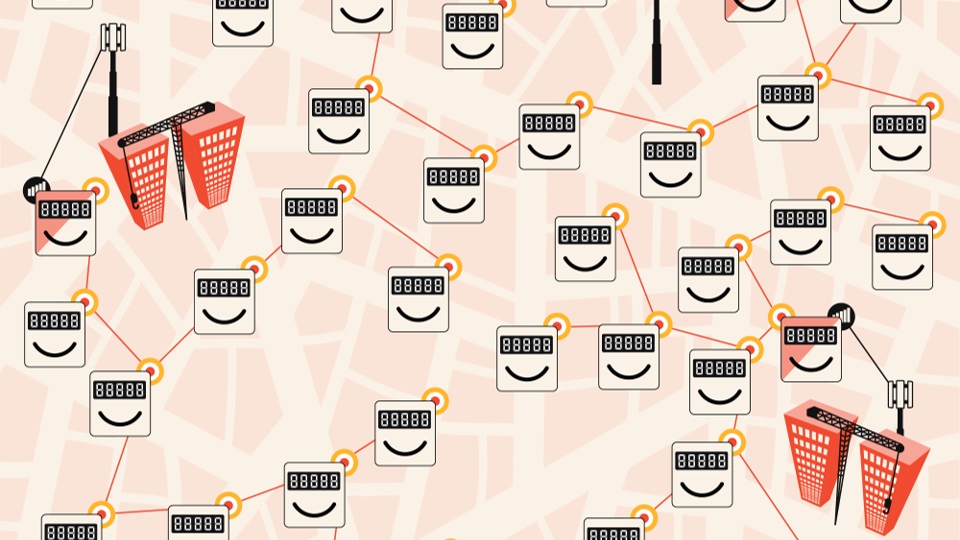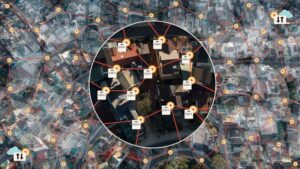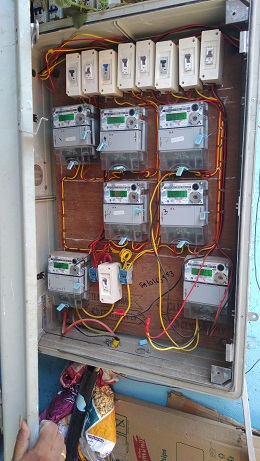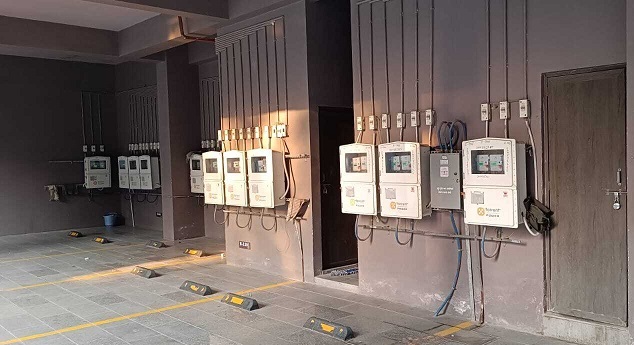Wirepas Oy of Finland is a leading provider of RF (radio frequency) mesh network technology for industrial and commercial IoT deployments, including smart metering. Wirepas has collaborated with several AMISPs in India and has to its credit 4.2 million smart meters using its patented technology. In this exclusive interview with T&D India, we have Jani Vehkalahti, Senior Vice President, Smart Grids at Wirepas, giving an in-depth understanding of RF mesh technology and how it scores over alternatives like cellular solutions, especially in the Indian context. Given India’s massive smart meter rollout under RDSS, Wirepas is poised for significant growth in the subcontinent, asserts Vehkalahti. An interview by Venugopal Pillai.

Wirepas, as we understand, provides RF mesh network for smart meters. Has Wirepas customized its solutions to suit India’s requirements?
Yes, Wirepas has tailored its RF mesh network to meet India-specific requirements while retaining its core global functionality. The network is adapted to comply with India’s IS15959 standards and operates within the local 865-868 MHz frequency band, as allocated by Indian regulators. This customization includes a reduced channel bandwidth and a data transmission rate adapted to the 3 MHz available spectrum, which differs from the wider 20 MHz spectrum commonly used in other regions.
Wirepas further supports network management with advanced tools like the Network Monitoring System (NMS) and a Network Optimization Tool to enhance network planning and performance. In addition, Wirepas offers a customized DLMS stack specifically designed for Indian metering systems, which speeds up implementation and streamlines integration into local smart grid projects.
How many smart meters are currently connected to Wirepas RF mesh in India, and what is the geographical footprint in terms of number of states covered?
Wirepas RF mesh currently connects 4.2 million meters across various states and Union territories in India, including Assam, Bihar, Gujarat, Jammu & Kashmir, Ladakh, Madhya Pradesh, Maharashtra, Uttar Pradesh, West Bengal, and more to follow.
Please discuss your partnership with HPL Electric & Power. What has been the outcome of the collaboration in terms of number of smart meters installed so far?
Wirepas has collaborated with HPL Electric & Power, a major player in electrical meter manufacturing, to enhance smart metering capabilities. This partnership focuses on integrating Wirepas’ RF mesh technology into smart meters for improved connectivity and performance. Majority of the installation will happen in 2025.
Tell us about other AMISPs in India with whom Wirepas is currently collaborating. Are these partnerships exclusive?
Wirepas licenses its software to multiple AMISPs in India without exclusive agreements, in line with Indian government guidelines that promote fair competition. Wirepas collaborates with several companies – including Adani, Anvil, Apraava, BCITS, Bosch, GMR, GVPR, Intellismart, Monte Carlo, NCC, Polaris, and Techno Electric & Engineering – to enable connectivity and robust RF mesh solutions. This open approach allows AMISPs to leverage Wirepas technology to meet the connectivity needs of the smart grid, including DC/RC requirements in compliance with the Standard Bidding Document (SBD).

In a general sense, how do you see RF-based communication solutions vis-à-vis alternatives like GPRS or NB-IoT, for instance, in the Indian context?
In India’s smart metering context, RF mesh networks like Wirepas offer significant advantages over cellular solutions like GPRS and NB-IoT, especially in terms of coverage reliability, long-term sustainability, and cost-effectiveness. Given India’s diverse and challenging terrains, Wirepas RF mesh has shown that it can maintain reliable performance across varied conditions—from Ladakh’s mountainous landscapes to densely populated urban centers. Here’s a closer comparison:
- Coverage and scalability
RF mesh: Wirepas RF mesh excels in extending coverage autonomously. Each smart meter in the network acts as a relay, forming a dense mesh that adapts to local conditions without the need for cellular towers. This capability is particularly beneficial in areas where cellular signals are unreliable or where meters are placed in challenging locations, such as underground metering rooms. In such scenarios, every meter enhances the network’s reach by connecting with other nearby meters, effectively bypassing physical obstructions and communication blackspots.
Cellular solutions: Cellular networks, often limited to single-operator coverage, face significant challenges in achieving consistent, country-wide coverage, especially in areas with complex terrain. In Europe, AMI Service Providers (AMISPs) use Mobile Virtual Network Operators (MVNOs) to expand coverage across different cellular networks, often achieving above 95 per cent coverage. However, in India, most AMISPs are limited to a single provider, such as Airtel or Jio, without the option to roam across networks, which impacts coverage reliability for cellular-based smart metering.
- Longevity and technology sustainability
 RF mesh: Wirepas RF mesh operates independently of cellular technology upgrades, meaning it doesn’t face the “sun-setting” risk associated with cellular networks. Cellular networks are periodically phased out, as seen with the ongoing transition from 3G to 4G and 5G, which can complicate the maintenance of long-term deployments like smart meters that require at least a 10- to 15-year lifespan. Wirepas RF mesh avoids this issue, as new hardware generations remain compatible with existing infrastructure, providing a stable long-term solution.
RF mesh: Wirepas RF mesh operates independently of cellular technology upgrades, meaning it doesn’t face the “sun-setting” risk associated with cellular networks. Cellular networks are periodically phased out, as seen with the ongoing transition from 3G to 4G and 5G, which can complicate the maintenance of long-term deployments like smart meters that require at least a 10- to 15-year lifespan. Wirepas RF mesh avoids this issue, as new hardware generations remain compatible with existing infrastructure, providing a stable long-term solution.
Cellular solutions: Cellular networks upgrade roughly every decade, and India is already seeing limitations as 3G is phased out to make way for 4G and 5G networks. This may necessitate upgrades to meters using cellular technology sooner than anticipated, leading to potential disruptions and additional costs if current cellular chips lack future compatibility.
- Cost-effectiveness
RF mesh: Wirepas RF mesh eliminates subscription and patent fees, which are typical with cellular technologies. This reduces the total cost of ownership over the smart meter’s lifetime, making RF mesh a more cost-effective solution for large-scale deployments. Maintenance is streamlined since network management is automatic, and any smart meter can act as an access point for neighboring meters, further enhancing network efficiency.
Cellular solutions: Cellular networks entail recurring subscription fees for each device, along with patent fees, which add to long-term expenses. Furthermore, maintaining cellular connectivity over a meter’s lifecycle could mean significant, ongoing costs for AMISPs, which may be less economically viable for large deployments.
- Reliability in dense urban and rural settings
RF mesh: In urban areas with dense populations, where meters are often concentrated in central meter rooms within multi-storied buildings, RF mesh networks handle the high density without the signal interference and congestion that can affect cellular networks. Moreover, Wirepas RF mesh technology has been demonstrated to work effectively even in rural and hilly areas, making it well-suited for India’s geographically diverse landscape.
Cellular solutions: Cellular networks often struggle with signal strength in underground or enclosed metering rooms. Moreover, adding infrastructure such as ad hoc antennas to improve connectivity in these environments can be costly and complex.
Wirepas recently collaborated with Netinium. Tell us more on the nature of this collaboration.
Wirepas’ collaboration with Netinium, a Head End System (HES) provider, focuses on creating a unified and interoperable communication framework. Netinium’s extensive experience with AMI rollouts in Europe complements Wirepas’ RF mesh technology, ensuring seamless data harmonization across mixed communication networks.
What impact could this collaboration have on Wirepas’ Indian operations?
This partnership allows Indian utilities to manage both Wirepas mesh and cellular networks through a single HES platform, simplifying system operations, enhancing data flow, and potentially accelerating adoption in India’s smart grid landscape.
In India, smart metering as a culture is new. Besides, there are other infrastructure-related adversities like difficult topography, for instance. Given this, what are the typical on-ground challenges during project execution?
 Deploying smart metering in India presents unique challenges due to varied topography, limited infrastructure, and connectivity issues. In addition, power and connectivity disruptions are common in some areas. Wirepas RF mesh network simplifies installation and accelerates deployment by creating a resilient, self-configuring mesh without reliance on cellular infrastructure.
Deploying smart metering in India presents unique challenges due to varied topography, limited infrastructure, and connectivity issues. In addition, power and connectivity disruptions are common in some areas. Wirepas RF mesh network simplifies installation and accelerates deployment by creating a resilient, self-configuring mesh without reliance on cellular infrastructure.
In addressing the specific requirements of India’s RDSS and SBD compliance, Wirepas has demonstrated that these standards are achievable through close collaboration with AMISPs, tailoring solutions to the country’s unique environment. This collaboration has enabled large-scale deployment that meets these regulations, proving functionality across challenging conditions.
Key advantages of Wirepas RF mesh for Indian smart metering are:
Dynamic network coverage: Many utilities lack comprehensive survey data needed for conventional network planning, often causing delays. Wirepas bypasses this issue by removing the need for upfront network planning. Instead, its self-configuring RF mesh builds coverage organically as meters are added, greatly speeding up the roll-out process.
Elimination of gateway dependencies: RF mesh networks generally require gateway devices to relay data to the head-end system, complicating deployment. Wirepas has overcome this limitation, allowing smart meters to function within the network without additional gateway devices, reducing installation complexity and cost. This is especially beneficial in remote or densely populated urban areas, where gateway placement could be impractical.
Could you briefly describe the various entities (partners) involved in a typical RDSS smart metering project in India? With which of these entities does Wirepas work with?
An RDSS smart metering project typically includes AMISPs who oversee system infrastructure and Service Level Agreements (SLAs), meter manufacturers supplying DLMS-compliant meters, and discoms as end-users. AMISPs select partners for Meter Data Management (MDM) and HES, as well as a communication solution, which in many cases is Wirepas RF mesh for its reliability and ease of deployment. Wirepas collaborates closely with AMISPs, meter manufacturers, and other system integrators to ensure efficient data communication and compliance with RDSS requirements, fostering a strong end-to-end smart metering system.
Which comes to your mind as your most challenging smart metering project in India so far? What were the challenges and how were they surmounted?
Every project in India presents unique challenges due to regional diversity, but Assam stands out for its varied topography and weather unpredictability. To overcome these, Wirepas leveraged localized expertise and adaptive deployment strategies, adjusting network configurations to address the complexities of each terrain. These customized approaches, combined with resilient technology, have enabled Wirepas to meet stringent SLAs and maintain reliable performance even in challenging regions.
In which countries has Wirepas deployed its RF mesh technology? Apart from India, are there untapped countries/regions that Wirepas sees potential in?
Wirepas RF mesh technology is deployed across regions including Europe, the US, Africa, Middle East, Australia, South Korea, and Southeast Asia. The company sees growth potential in Southeast Asia, Africa, and Latin America, where expanding smart grid and IoT infrastructure creates new opportunities for scalable and reliable connectivity solutions.

Under RDSS, India has envisioned the rollout of 250 million smart meters. Assuming that this rollout materializes, there will be a massive smart metering ecosystem that would need ongoing maintenance. What challenges do you see on this front?
Wirepas anticipates several challenges in maintaining India’s smart metering infrastructure, which includes factors such as network uptime, scalability, and technical training.
Sustaining network uptime: By utilizing an RF mesh network, Wirepas reduces the need for centralized maintenance systems, as the network is inherently capable of managing itself. This network design makes it easier to maintain uptime across large, dispersed areas without the need for complex, centralized infrastructure.
Scaling to support growing populations: Wirepas RF mesh technology is designed to grow organically, with new meters added to the network without the need for extensive re-planning or hardware overhauls. Each new meter acts as a node in the mesh, helping to extend coverage and capacity. This distributed approach to network expansion significantly eases the strain of scaling the smart metering system, allowing for seamless integration of new devices as demand increases.
Ongoing technical training and support: Smart metering systems require continuous monitoring, maintenance, and troubleshooting by local teams, many of whom may not be familiar with the intricacies of the technology or network management. Given that the Wirepas RF mesh network is self-managing and requires minimal intervention, the overall maintenance complexity is reduced compared to cellular-based solutions.
Future-proofing and technology evolution: Smart meters are expected to have a lifetime of up to 10 years. Maintaining compatibility with future technologies is crucial for sustainability. Wirepas addresses this challenge by focusing on a future-proof network design. The RF mesh network does not rely on specific cellular technologies, making it less susceptible to the obsolescence of individual network generations. New hardware can be integrated into the system without requiring extensive system redesigns, thus ensuring that the smart metering network remains operational long after the rollout phase.
How do you see the growth of Wirepas in India backed by the massive smart metering mission that India has undertaken?
Wirepas is poised for significant growth in India, supported by the extensive RDSS smart metering initiative. With a large-scale deployment underway, Wirepas’ RF mesh technology is well-positioned to play a crucial role in India’s smart grid transformation, demonstrating its scalability and effectiveness across diverse environments.
All photographs seen in this interview relate to technical illustrations of Wirepas RF mesh technology or smart metering projects of Wirepas.


